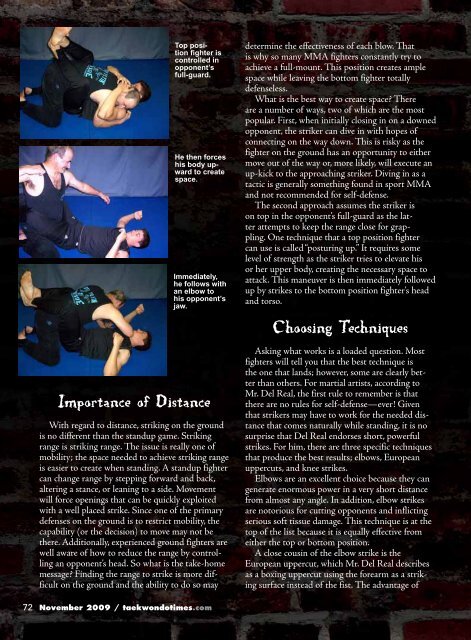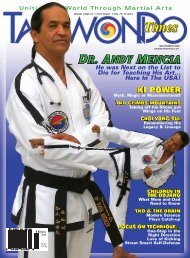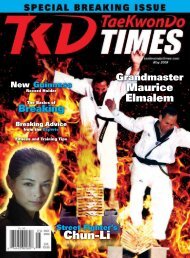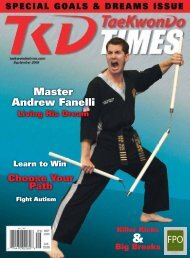Grandmaster Ken MacKenzie - Taekwondo Times
Grandmaster Ken MacKenzie - Taekwondo Times
Grandmaster Ken MacKenzie - Taekwondo Times
Create successful ePaper yourself
Turn your PDF publications into a flip-book with our unique Google optimized e-Paper software.
Top position<br />
fighter is<br />
controlled in<br />
opponent’s<br />
full-guard.<br />
He then forces<br />
his body upward<br />
to create<br />
space.<br />
Immediately,<br />
he follows with<br />
an elbow to<br />
his opponent’s<br />
jaw.<br />
<br />
With regard to distance, striking on the ground<br />
is no different than the standup game. Striking<br />
range is striking range. The issue is really one of<br />
mobility; the space needed to achieve striking range<br />
is easier to create when standing. A standup fighter<br />
can change range by stepping forward and back,<br />
altering a stance, or leaning to a side. Movement<br />
will force openings that can be quickly exploited<br />
with a well placed strike. Since one of the primary<br />
defenses on the ground is to restrict mobility, the<br />
capability (or the decision) to move may not be<br />
there. Additionally, experienced ground fighters are<br />
well aware of how to reduce the range by controlling<br />
an opponent’s head. So what is the take-home<br />
message? Finding the range to strike is more difficult<br />
on the ground and the ability to do so may<br />
determine the effectiveness of each blow. That<br />
is why so many MMA fighters constantly try to<br />
achieve a full-mount. This position creates ample<br />
space while leaving the bottom fighter totally<br />
defenseless.<br />
What is the best way to create space? There<br />
are a number of ways, two of which are the most<br />
popular. First, when initially closing in on a downed<br />
opponent, the striker can dive in with hopes of<br />
connecting on the way down. This is risky as the<br />
fighter on the ground has an opportunity to either<br />
move out of the way or, more likely, will execute an<br />
up-kick to the approaching striker. Diving in as a<br />
tactic is generally something found in sport MMA<br />
and not recommended for self-defense.<br />
The second approach assumes the striker is<br />
on top in the opponent’s full-guard as the latter<br />
attempts to keep the range close for grappling.<br />
One technique that a top position fighter<br />
can use is called “posturing up.” It requires some<br />
level of strength as the striker tries to elevate his<br />
or her upper body, creating the necessary space to<br />
attack. This maneuver is then immediately followed<br />
up by strikes to the bottom position fighter’s head<br />
and torso.<br />
<br />
Asking what works is a loaded question. Most<br />
fighters will tell you that the best technique is<br />
the one that lands; however, some are clearly better<br />
than others. For martial artists, according to<br />
Mr. Del Real, the first rule to remember is that<br />
there are no rules for self-defense—ever! Given<br />
that strikers may have to work for the needed distance<br />
that comes naturally while standing, it is no<br />
surprise that Del Real endorses short, powerful<br />
strikes. For him, there are three specific techniques<br />
that produce the best results; elbows, European<br />
uppercuts, and knee strikes.<br />
Elbows are an excellent choice because they can<br />
generate enormous power in a very short distance<br />
from almost any angle. In addition, elbow strikes<br />
are notorious for cutting opponents and inflicting<br />
serious soft tissue damage. This technique is at the<br />
top of the list because it is equally effective from<br />
either the top or bottom position.<br />
A close cousin of the elbow strike is the<br />
European uppercut, which Mr. Del Real describes<br />
as a boxing uppercut using the forearm as a striking<br />
surface instead of the fist. The advantage of<br />
72 November 2009 / taekwondotimes.com













